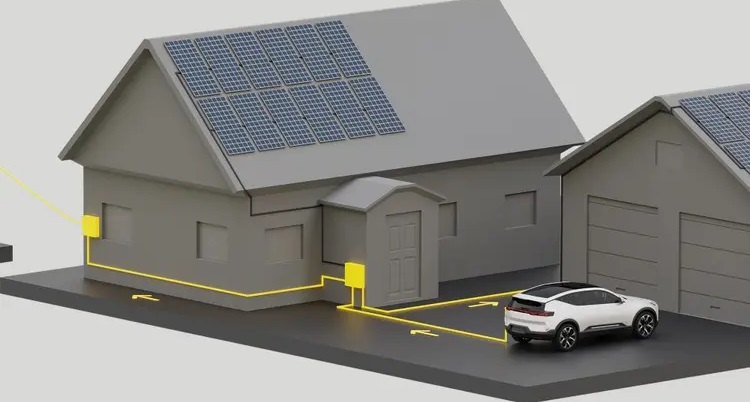The European Association for Electromobility (AVERE) hosted a webinar on the Vehicle-to-Grid (V2G) technology.
During the event, Emanuella Wallin, Product Owner for Charging and Product Leader for V2G at Polestar, and Mark van Eijk, Research Engineer at Alfen, engaged in a dialogue on this topic.
Each participant brings a contrasting perspective on this emerging system, which arises as a renewable energy alternative for the charging infrastructure market, in a context where the European Union (EU) sets ambitious targets for member states to achieve zero emissions by 2050.
Indeed, AVERE is involved in various projects to promote the Vehicle-to-everything (V2X), such as the “Scale” program.
This initiative aims to align smart charging for Europe, promoting both technologies on the continent and preparing products for the massive implementation of electric vehicles (EVs).
Now, what is the difference between V2G and V2X?
On the one hand, through V2G, energy can be sold to the electrical grid by the driver of an EV or plug-in hybrid when the unit is connected at times it is not being used for transportation.
In the case of V2X, it involves communication between a car and any entity that can affect or be affected by it.
With the context set, let’s revisit the perspectives summarized by Mobility Portal Europe. What viewpoints did each speaker articulate?
Benefits the V2G network provides

From Emanuella Wallin’s standpoint, Polestar is convinced that this is the path Europe should take for the future.
“Vehicles are parked 90 percent of the time, so we can do something to make them as useful when parked as when they’re actually being used“, Wallin asserts.
And she continues: “We see a great potential from the driver and customer standpoint, as with bi-directional charging, the EV would become a battery storage and also provide the opportunity for owners to participate in the energy market.“
From the perspective of an electric car manufacturer, the adoption of V2G aligns with their commitment to sustainability and the transition to cleaner energy sources.
Wallin acknowledges that implementing this technology will not only increase the value of the physical asset but also play a significant role in accelerating global renewable energy adoption.
The Swedish corporation has been actively involved in research and development projects related to this new solution, collaborating with industry partners and academic entities to explore its feasibility and potential.
Other V2X-related plans have been integral to this study, where the company has been working on developing technical capabilities through testing in laboratory environments.
Additionally, it is expanding its scope with the implementation of a large-scale pilot program in real-world environments, called PAVE, to evaluate and refine user experience and associated business models.
“We hope that with the PAVE project, we pave the way for others and prepare ourselves for the future of V2G in society,” declares Wallin.
Why do some sector experts believe it cannot yet be applied?

Mark van Eijk brings up Alfen‘s viewpoint, a leading company in manufacturing charging equipment, smart grid solutions, and energy storage systems based in the Netherlands.
The engineer conducted a master’s thesis focused on delving into the technical and regulatory barriers that hinder the widespread adoption of Vehicle-to-Grid technology.
“V2G technology is in its infancy with a lack of uniformity in communication protocols, standards, and commercial applications, which is why I initiated my project,” van Eijk explains.
Through exhaustive research and interviews with key stakeholders, he identified four main institutional barriers affecting technical implementation.
One of the central concerns was the lack of clarity and standardization that complicates the smooth integration of the technology into the European market, which in turn affects the willingness of manufacturers and charging system operators to fully adopt the system.
Alfen’s representative elaborates: “There is a risk of market fragmentation where EV automakers generally want to offer a single car or unique products for all European markets”
“However, each country has different requirements, so, if they have to adapt to each market, it can become quite complicated for them overall”, he adds.
Another highlighted challenge is the uncertainty surrounding grid codes, both at the European and national levels.
The shortage of specificity in requirements for V2G integration into these codes complicates the planning and execution of projects related to this technology, generating additional concerns for manufacturers and electric system operators.
The third barrier mentioned relates to communication infrastructure between EVs, distribution system operators (DSOs), and charging systems.
The insufficiency of interoperability and clear standards in this regard complicates the practical implementation of V2G and poses additional challenges for market actors.
Finally, decision-making regarding load and discharge management in the context was also identified as an obstacle.
Diversities in interests and objectives among EV automakers, charging system operators, and regulators can hinder the creation of a coherent framework for system implementation.
Despite these hurdles, the researcher recognized the importance of collaboration and coordination among all stakeholders to effectively address these issues.
Ultimately, van Eijk exemplifies, “We have electric car manufacturers looking for V2G-compatible charging stations to experiment with the technology.”
“Now, on the other end, we have zero-emission vehicle producers and charging point operators (CPOs) waiting for EVs offering that technology”, he concludes.








